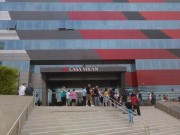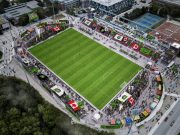According to a KMPG analysis, at the end of last year, Juventus FC announced operating revenues for the 2015/16 season of €341 million, more than twice the figure for 2010/11, and a net profit of €4 million for the second successive season, after five years of absolute success.
When Agnelli was appointed in 2010, he became the fourth member of the family to become President of Juventus FC, inheriting a club that was still trying to overcome the fallout of Calciopoli (Juventus was found guilty and relegated to Serie B – the Italian second division). While the club’s situation did not alter greatly in his initial season, the club’s turnaround gathered momentum with the inauguration of the wholly-owned, new Juventus Stadium in September 2011.
The club’s new home, with 14,000 more seats than the Stadio Olimpico and a higher proportion of hospitality seats, was a landmark moment not only for Juventus FC but also for Italian football, as the vast majority of Serie A clubs still play in municipality-owned facilities and cannot capitalize on the competitive advantages of owning their own stadium. Since the inauguration of Juventus Stadium, the Old Lady has not only recorded an impressive win rate of 78% (105 of 134 home matches) but also increased matchday revenues at a Compound Annual Growth Rate (CAGR) of 31%, from €11.5 million in 2010/11 (the last year at the Stadio Olimpico) to €44.1 million at the end of last season, according to KPMG.

At this time, commercial revenue also increased (CAGR of 14%) as Juventus profited from their growing international exposure, surpassing AC Milan as the most followed Italian club on social media, and partially bridging the gap with their major European counterparts.

Juventus’ deal with technical sponsor Adidas (€23 million compared to the previous €13 million deal signed with Nike), and an increased jersey sponsor deal with Jeep (€17 million compared to €13 million previously) and the club’s successful direct control of licensing and merchandising made it possible for the club to end last season up in commercial revenue by €27 million.
In addition, Juventus FC has also started working on the JVillage, a development in the proximity of their stadium that is scheduled to open by the end of 2017. It will include the new headquarters and training center, a hotel, a concept store and an international school for young players.
Despite the increase in commercial income, Juventus’ main source of revenue is still broadcasting, accounting for 57% of the total for 2015/16. Juventus’ recent success and the collective distribution process in place for broadcasting revenues in Italy, based on historical results and fan base, makes the club one of the highest earners from this source across the whole of Europe in domestic terms. However, a vital segment of that income is derived from their continued participation in the UEFA Champions League, which in 2015/16 accounted for €76 million in prize money.

Rising staff costs and amortization of players’ registrations (CAGR of 12% and 14%, respectively, during this period) seems justified by Juventus FC winning five domestic titles in a row, a sequence that has not been achieved in Italian football since the 1930s.
Although Juventus Stadium has proved to be a crucial competitive advantage so far, some challenges remain for the club. Matchday revenues, limited by capacity and ticket prices, may not show a significant increase in the next few years. Furthermore, Italy’s Serie A has lost appeal in recent seasons. The league’s domestic broadcasting revenues, already in third place among the “big five”, will also be exceeded by the Bundesliga from 2017/18.
As a result, Juventus FC must continue to grow their commercial revenues, monetizing on the club’s broad popularity and building a presence in overseas markets, in order to remain competitive on the international stage.







































